The 10 most secure locations in the world


Cheyenne Mountain Complex
Located under 2,000 feet of granite in Colorado Springs, Colo., this nuclear-blast-proof facility is home to the North American Aerospace Defense Command (NORAD). Cheyenne Mountain Complex has its own self-contained power plant, water supply, heating system, hospital and more -- everything NORAD needs to keep operating during DefCon 1.
721st Mission Support Group Deputy Direct Steven Rose told Airman Magazine that its operation compared to that of an underground city.
Cheyenne's 25-ton north blast doors
Cheyenne Mountain Complex is the only high-altitude facility certified by the Department of Defense to withstand an electromagnetic pulse (EMP). Its 25-ton blast doors also protect against biological and nuclear attack.
The public is not allowed to visit. You can, however, take a virtual tour of the Cheyenne Mountain Complex facility on our sister site, CNET.
Vatican Secret Archive, Rome
Built more than 400 years ago, the Vatican Secret Archives hold some of the most important and oldest religious documents in existence, including the papal bull that excommunicated Martin Luther, letters from Michaelangelo, and a transcript of Galileo's trial.
You can take a look inside parts of the Vatican Secret Archive in this segment by 60 Minutes.
Serving 16th-century Renaissance realness
The archives are protected, in part, by the Pontifical Swiss Guard. Don't let the halberds and Renaissance-style uniforms fool you: These men have all completed training with the Swiss Armed Forces and are equipped with pistols, rifles and submachine guns.
Scholars can apply for entry to the Vatican Secret Archives, but access is highly limited. All documents dated after 1939 are completely off-limits to public viewing. And no browsing is allowed.
United States Bullion Depository at Fort Knox, Kentucky
Completed in 1936, the United States Bullion Depository at Fort Knox presently holds 147.3 million ounces of gold owned by the U.S. government, worth roughly $200 billion. During World War II, the vault also held the U.S. Declaration of Independence and Constitution, Hungary's Crown of St. Stephen (for safe keeping) and a supply of processed opium.
Actual Fort Knox gold bars
To prevent theft, the 20-ton vault doors are sealed with tamper-evident tape and hot sealing wax that holds a card signed by three representatives of the U.S. government, according to Numismatic News.
Visitors to the bullion vaults are strictly prohibited. Secretary of the Treasury Steven Mnuchin did make an inspection of the vault with members of congress on August 21, 2017, however -- it was the first such visit in over 42 years.
Federal Reserve Bank of New York
Fort Knox isn't the largest known store of gold in the world, however. That distinction goes to the Federal Reserve Bank of New York, which holds 6,350 tons (as of 2015) of the precious metal 80 feet below street level in Manhattan.
The vault is protected by this 90-ton steel cylinder set in a 140-ton concrete frame which, when closed, creates a water- and air-tight seal. Security inside the vault is so tight that a three-person internal team must be present any time one of its compartments are open.
Gold stored inside the Federal Reserve
Approximately 98 percent of the gold kept at the Federal Reserve is owned by foreign nations. Each account holder is assigned its own padlocked and sealed compartment so gold bars never commingle, ensuring an owner can only withdraw the exact same bars they deposited.
Groom Lake (Area 51), Nevada
Area 51, a "top secret" part of Edwards Air Force Base by the Groom Lake salt flat, is arguably the most highly classified military facility in the United States. It was the only location on Earth that astronauts aboard Skylab 4 were prohibited from photographing in 1974. (They photographed it anyway.)
This is what people in the '60s mistook for UFOs
Though the current purpose of the facility is "top secret," a 2013 Freedom of Information Act response by the CIA revealed that Groom Lake was originally established in 1955 to test U-2 spy planes. Project OXCART was established soon after in 1959, to test the Lockheed A-12, resulting in a major expansion of the facility.
Here, the Lockheed A-12 makes its maiden flight from Groom Lake on April 26, 1962.
Svalbard Global Seed Vault, Norway
Built in the depths of the Arctic Circle, this doomsday vault was built to store backup copies of seeds held in other seed banks. As of February 2017, Svalbard held over 930,000 samples, each consisting of 500 seeds.
Inside the doomsday seed vault
The facility is located 390 feet inside a permafrosted mountain on Spitsbergen Island, well above sea level. Seeds inside the vault are stored in air-tight aluminum bags at a temperature of -18 degrees Celsius.
Even if the cooling system fails, the seed vault is designed to stay below freezing for at least 200 years. That's an important feature: Some of the vault's seeds could be viable for thousands of years.
Air Force One
The full extent of Air Force One's defenses are classified, but there's a lot we know about the president's famous plane. It's heavily shielded, capable of jamming enemy radar and has flares to defeat heat-seeking missiles. And plenty of Secret Service members are on hand to protect the president from any on-board threats.
When not in use, the plane is kept behind high security at Joint Base Andrews.
Inside Air Force One on 9/11
Because of its mobile status, Air Force One is even more secure than the White House in times of crisis. During the attacks of September 11, President George W. Bush spent 8 hours in the mobile command center, escorted by F-16 fighter jets for protection.
In the event of a prolonged attack, Air Force One can be refueled in midair.
Pionen Data Center, Sweden
Built inside a Cold War-era bunker below 100 feet of granite, Bahnhof's Pionen data center is the most secure in the world. Even if nuclear war devastates the Earth, data inside the facility will remain protected, thanks to its 40-centimeter thick steel doors.
"I'm not sure about the people," said Bahnhof Chairman Jon Karlung, "but the machines would survive."
This data will survive the apocalypse
Data at Pionen is well protected from failure. The two submarine engines seen here function as backup power generators.
Pionen is well protected legally, too. In 2010, WikiLeaks housed its servers here.
Iron Mountain, Boyers, Pennsylvania
Many of the world's most important commercial documents and treasures are kept here, 220 feet underground in a former limestone mine in Boyers, Pennsylvania. The high-security and temperature-controlled facility, owned by Iron Mountain, holds the original negatives for more than 120,000 Hollywood movies.
Iron Mountain's greatest treasures
Iron Mountain's Boyer location's most valuable treasure may be this 27-million-piece Corbis image collection owned by Bill Gates. It includes the glass plate negatives for some of the most important photographs ever taken, including these iconic shots of Albert Einstein and Marilyn Monroe.
You can take a look at some of Iron Mountain's other treasures in this segment by local CBS news station KDKA.
The Korean Demilitarized Zone
The Korean Demilitarized Zone (DMZ), a 2.5-mile-wide strip of land that acts as a buffer between North and South Korea, is one of the most aggressively protected areas in the world.
No one is allowed to cross the DMZ. Those who try are met with deadly force: More than 800 soldiers have died in the DMZ since its creation in 1953.
DMZ: A safe-haven for wildlife
The lack of a human presence inside the DMZ has been a major boon to wildlife. The 160-mile-long area now acts as an involuntary nature reserve, where several endangered plants and animals (including the Siberian tiger and white-naped crane) have thrived.